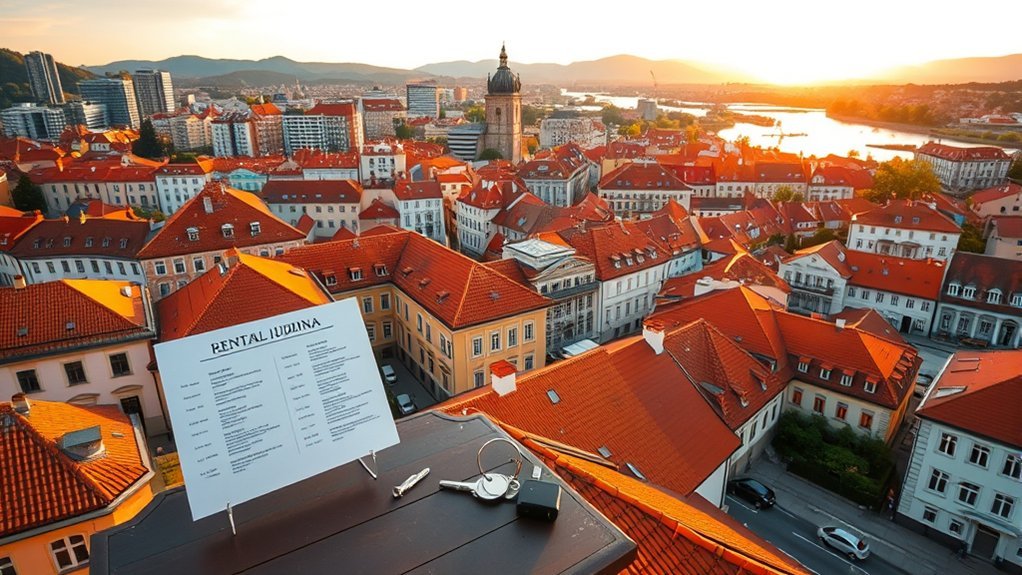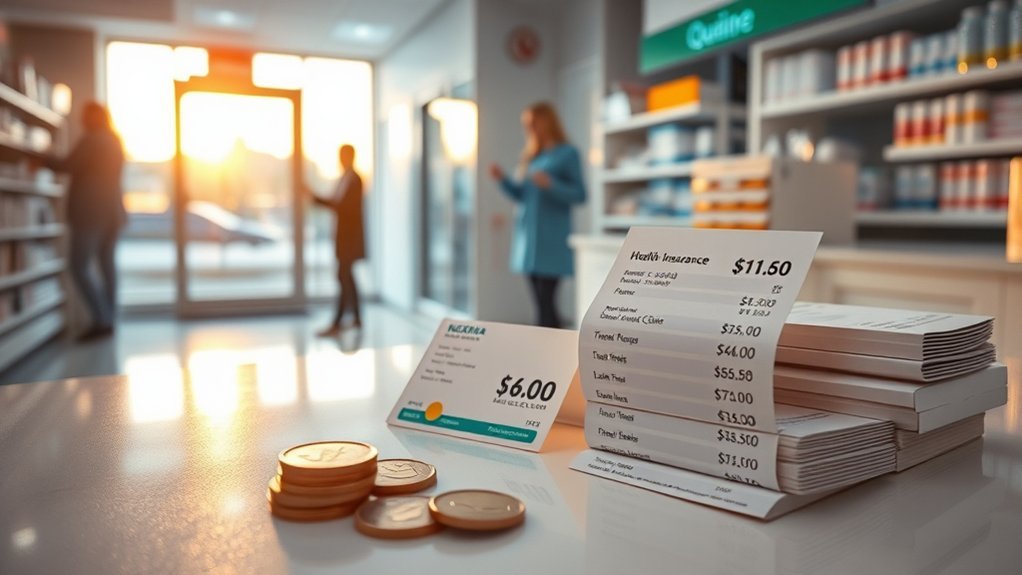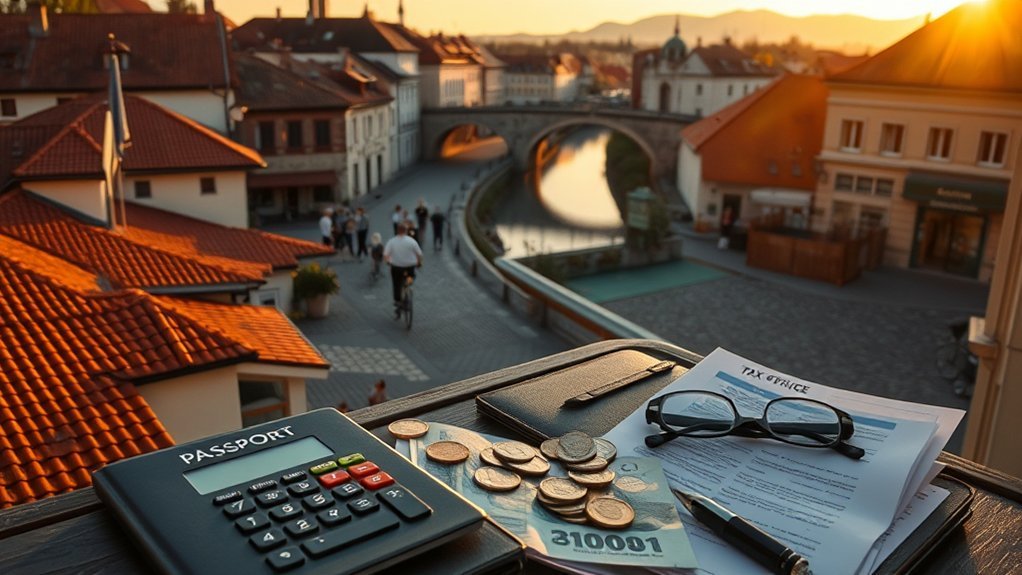You can live comfortably in Slovenia on about €600–€1,200 per month as a single person, with city-center one‑bed rents typically €600–€800 and outside-center options €400–€600. Expect utilities around €150–€250, internet ≈€33.50, groceries €200–€300, and monthly transit ≈€30–€40. Families often budget €3,000–€5,000 for a comfortable lifestyle. Healthcare is mostly public with modest compulsory premiums. Keep these benchmarks in mind if you want a detailed breakdown of costs and choices.
Cost of Living Overview and Monthly Budgets

Although Slovenia is more affordable than many Western European countries, you’ll still want a clear budget: the average monthly cost of living is about $1,468 (placing Slovenia 38th out of 197 for affordability).
Use that figure as a baseline for individual expenses: utilities run about $181 per month, and reliable internet (50 Mbps+) averages $33.50.
City-center rents illustrate scale — a one-bedroom averages $723 and a three-bedroom $1,427 — but we’ll cover housing in the next subtopic.
For expat families, plan between $3,000 and $10,000 monthly; a $5,000 pre-tax baseline gives you a comfortable lifestyle including private schooling, which can add roughly $2,000 or more per month depending on choice and location.
Analyze trade-offs: prioritize private school or higher rent, not both, if your budget’s fixed.
Track actual spending against these benchmarks to refine your Cost of Living assumptions and avoid surprises.
Housing and Rental Prices Across Cities

Now let’s look at housing costs, which are the biggest variable in any budget. If you’re living in Slovenia you’ll find clear city-to-country differentials: a one-bedroom in Ljubljana’s center averages $740/month, $618 outside center, while a three-bedroom in center hits about $1,427/month.
Compared with major U.S. cities — New York one-bed $2,900–$3,900 — Slovenian rents are roughly 190% lower on average, so you’ll save substantially if relocating.
- Urban centers command premiums; central Ljubljana is exceptionally pricier.
- Larger units multiply costs; three-bed central units cost nearly double one-beds.
- Rural and suburban options reduce rent but may increase commute time.
- Families should research neighborhoods for schools, transport, and space needs.
You should factor location, unit size, and lifestyle when budgeting. Use local listings to benchmark neighborhoods and anticipate trade-offs between rent savings and access to services while living in Slovenia.
Grocery, Dining and Daily Expenses

When you budget daily living costs in Slovenia, groceries and dining stay particularly affordable: a liter of whole milk runs about €4.63, 12 large eggs €1.21, 1 kg of tomatoes €2.39 and 1 kg of potatoes €1.40, while a basic pub dinner for two costs roughly €33 and an Italian dinner with wine about €50.
You’ll find grocery staples competitively priced, so cooking at home lowers your monthly food spend. Expect fast-food meals around €9.16 and set lunch menus near €14.50, which you can use as benchmarks when comparing eating out versus preparing meals.
If you eat out selectively—pubs for casual nights and restaurants for occasional splurges—you’ll control dining costs effectively. Factor in local produce prices; tomatoes and potatoes illustrate consistent value.
Use these data points to model weekly and monthly grocery allocations, adjusting for household size and frequency of dining out. This lets you forecast food expense reliably within your overall budget.
Transportation, Utilities and Internet Costs

If you rely on public transit, a monthly local ticket runs about €39 while single rides cost roughly €1.66, which makes commuting by bus or tram cost-effective for regular travel compared with taxis (an 8 km ride averages €12.60) or driving your own car where fuel sits near €1.71 per liter.
Add typical single-person utilities of €181/month and high-speed internet around €33.50/month to model your fixed monthly housing and connectivity expenses.
You’ll find Living in Slovenia favors public transportation in urban areas: monthly passes quickly undercut frequent taxi use or car operating costs.
Utilities and internet costs are predictable components of your budget, with utilities covering electricity, heating and water.
Combine these figures to estimate baseline monthly outlays for a single person and compare scenarios (public transit vs. car ownership).
Data-driven budgeting helps you decide whether to keep a car or rely on Slovenia’s transport network and affordable utilities and internet costs.
- Public transit is the cost-efficient baseline
- Taxis are convenient but pricier
- Fuel raises car ownership expenses
- Utilities + internet are stable monthly costs
Healthcare, Insurance and Medical Expenses

Although you’ll pay compulsory health insurance to stay covered, Slovenia’s public system delivers broadly reliable care at a predictable cost: compulsory premiums generally run under $450/month, doctor visits are fully covered, and prescription drugs cost roughly 10% of U.S. prices. You’ll find a system ranked 46/93 by Numbeo that balances cost and quality. All residents pay taxes in Slovenia, which fund the coverage and guarantee routine access. Private care exists: expect about €66 for a 15-minute consult if you prefer faster appointments or specialists. For budgeting, treat compulsory premiums and occasional private visits as core components. Compare public coverage reliability to private out-of-pocket flexibility when estimating yearly healthcare spending.
| Item | Typical cost/metric |
|---|---|
| Compulsory premium | < $450/month |
| Doctor visit (public) | Covered |
| Prescription drugs | ~10% of U.S. prices |
| Private short visit | ~€66 |
| Numbeo rank | 46/93 |
Taxes, Residency Permits and Retirement Requirements

Healthcare costs and coverage shape your budget, but residency and tax rules determine whether you can stay and how much you’ll owe. You can get a one‑year temporary residence permit as a U.S. citizen, renewable annually, and apply for permanent residency after five years.
To qualify you must prove monthly income roughly $1,000. Slovenia lacks a specific retirement visa, so retirees must secure alternative permits and plan documentation and income proofs.
Taxation is global: residents pay income tax from 16% to 50%, plus a 25% capital gains tax. That tax profile affects where you live—cities in Slovenia differ in cost and administrative access—so location influences net retirement income and service availability.
It’s crucial to consult an accountant versed in Slovenian and U.S. tax codes to minimize double taxation and optimize residency strategy.
- Temporary permit renewable annually
- Proof of ~ $1,000 monthly income required
- Global taxation: 16%–50%; 25% capital gains
- No designated retirement visa; plan alternatives
Education, Childcare and Expat Community Resources

When planning a family budget in Slovenia, factor in that private international schooling can add €2,000+ per month while local gimnazija and Waldorf options often cost substantially less. Public schools teach primarily in Slovenian, so language proficiency or extra tuition can become an added expense.
Private international schools may add €2,000+ monthly; local gimnazija/Waldorf cost less, but public schools require Slovenian or extra tutoring.
You should evaluate total annual costs: tuition, uniforms, materials, extracurriculars and transport. If you lack Slovenian, budget for language courses or private tutoring—these can be several hundred euros monthly per child.
Childcare availability varies; licensed kindergartens are affordable relative to private care, but demand in urban centers can drive private rates up. Tap expat communities and online groups for comparative pricing, school reputations and application timing—peer data often uncovers savings and faster placements.
Use a simple spreadsheet to compare international versus local options over a multi-year horizon, including hidden costs. That analytic approach lets you quantify trade-offs between educational quality, language barriers and monthly cashflow, informing a defensible family choice.
Frequently Asked Questions
Can US Citizens Live in Slovenia?
Yes — you can live in Slovenia on a one-year temporary residence permit (renewable). You’ll need to show roughly $1,000 monthly income; after five years’ temporary residence you can apply for permanent residency.
What Is the Average House Price in Slovenia?
Average house prices in Slovenia vary, but you’ll find one-bedroom rents around $618–$740 monthly and three-bedroom city-center rents about $1,427; overall housing costs are roughly 190% lower than U.S. averages, indicating affordability.
How Much Money Do You Need to Retire in Slovenia?
You’ll need roughly $1,468 monthly on average to retire comfortably in Slovenia, plus proof of about $1,000 monthly for residency; budget higher for Ljubljana rent, up to $740, and account for taxes and health insurance.
What Is the Average Rent in Slovenia?
On average, you’re paying about $740 monthly for a one‑bedroom in Ljubljana’s center and $618 outside; three‑bedrooms run roughly $1,427 in center — overall rents are dramatically lower than U.S. levels, often much cheaper.
Conclusion
Living in Slovenia is affordable compared to Western Europe: average monthly costs for a single person range around €800–€1,200 (excluding rent), while a one-bedroom in Ljubljana averages €600–€800. You’ll save on groceries and healthcare but should budget for utilities and private insurance if needed. Given Slovenia’s 92% internet coverage and reliable public transit, you can expect efficient, low-stress living. Use these figures to plan a realistic monthly budget tailored to your city and lifestyle.


